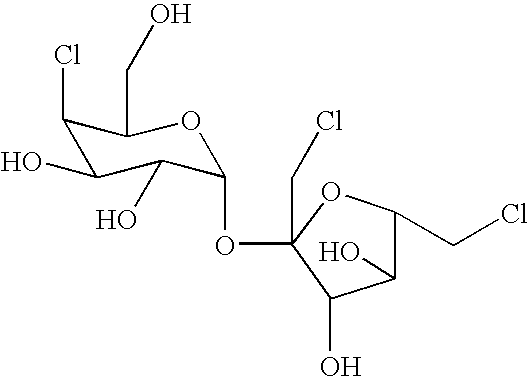Method for the purification of sucralose
a technology of sucralose and purification method, which is applied in the field of purification method of sucralose, can solve the problems of difficult synthesis of sucralose, inability to meet the requirements of large-scale commercial production of highly pure sucralose, and inability to isolate sucralose in highly pure form from this complex mixture of contaminants. achieve the effect of increasing purity
- Summary
- Abstract
- Description
- Claims
- Application Information
AI Technical Summary
Benefits of technology
Problems solved by technology
Method used
Image
Examples
example 1
[0039] To a crude syrupy sucralose reaction mixture (10 g) containing 85-92% (by wt.) of sucralose was added methanol (10 mL). The mixture was stirred at room temperature for 2 hours. The mixture was decanted. This step removes polar impurities. The residual crude sucralose was stirred in dichloromethane, water and t-butyl methyl ether (10 mL, 1:1:1 by volume). The mixture was heated to 60° C. for 30 minutes. After cooling to room temperature, the aqueous layer containing sucralose was separated. The sucralose is in the water layer. This step removes mainly non-polar impurities. To the aqueous solution containing sucralose were added water and ethyl acetate (6.3 and 10 mL respectively). The mixture was stirred at room temperature for 24 hours. The mixture was allowed to stand for 30 minutes and then the organic solvent was decanted. This step also removes non-polars. The aqueous layer was evaporated under reduced pressure at 40-50° C. to get syrup. The process improves the purity of...
example 2
[0040] To a crude syrupy sucralose reaction mixture (10 g) containing 85-92% (by wt.) of sucralose was added methanol (10 mL). The mixture was stirred at room temperature for 2 hours. The mixture was decanted. This step removes polar impurities. To the residual crude syrupy sucralose reaction mixture (10 g) containing 85-92% (by wt.) of sucralose was added water: ethyl acetate (10 mL, 1:1 by volume). The mixture was stirred at room temperature for 24 hours. The mixture was allowed to stand for 30 minutes and then the aqueous organic solvent was decanted. The process improves the purity of sucralose to 97-99% but the product is still syrupy. To this partially purified sucralose syrup was added water: ethyl acetate (20 mL, 1:1 by volume). The mixture was heated to 60° C. for 30 minutes until a clear solution was obtained. After cooling the solution to 25° C., crystallization was initiated by seeding with 0.01 g of pure sucralose crystals. The solution was then cooled with no agitation...
example 3
[0041] To a crude syrupy sucralose reaction mixture (10 g) containing 85-92% (by wt.) of sucralose was added methanol (10 mL). The mixture was stirred at room temperature for 2 hours. The mixture was decanted. This step removes polar impurities. To the residual crude syrupy sucralose reaction mixture (10 g) containing 85-92% (by wt.) of sucralose was added water: toluene (10 mL, 1:1 by volume). The mixture was stirred at room temperature for 24 hours. The mixture was allowed to stand for 30 minutes and then the aqueous organic solvent was decanted. The process improves the purity of sucralose to 97-99% but the product is still syrupy. To this partially purified sucralose syrup was added water: toluene (20 mL, 1:1 by volume). The mixture was heated to 60° C. for 30 minutes until a clear solution was obtained. After cooling the solution to 25° C., crystallization was initiated by seeding with 0.01 g of pure sucralose crystals. The solution was then cooled with agitation to 5° C. over ...
PUM
 Login to View More
Login to View More Abstract
Description
Claims
Application Information
 Login to View More
Login to View More - R&D
- Intellectual Property
- Life Sciences
- Materials
- Tech Scout
- Unparalleled Data Quality
- Higher Quality Content
- 60% Fewer Hallucinations
Browse by: Latest US Patents, China's latest patents, Technical Efficacy Thesaurus, Application Domain, Technology Topic, Popular Technical Reports.
© 2025 PatSnap. All rights reserved.Legal|Privacy policy|Modern Slavery Act Transparency Statement|Sitemap|About US| Contact US: help@patsnap.com

